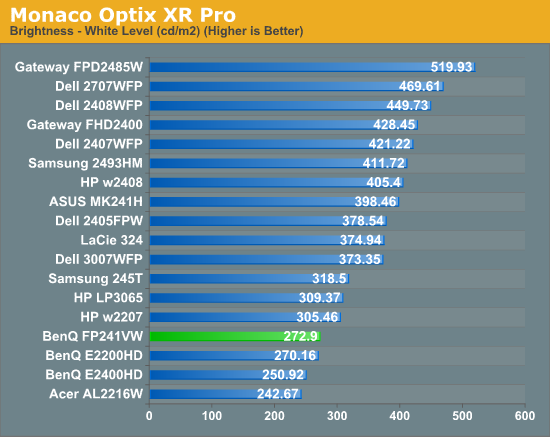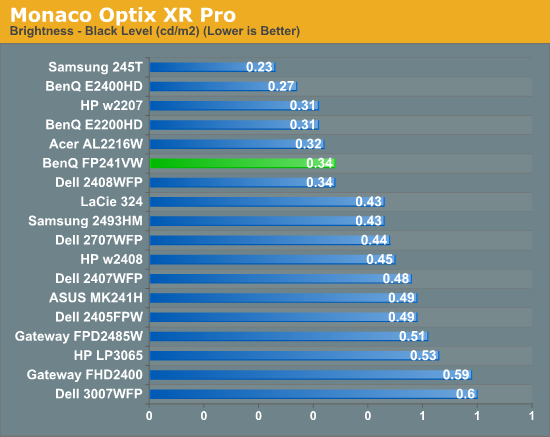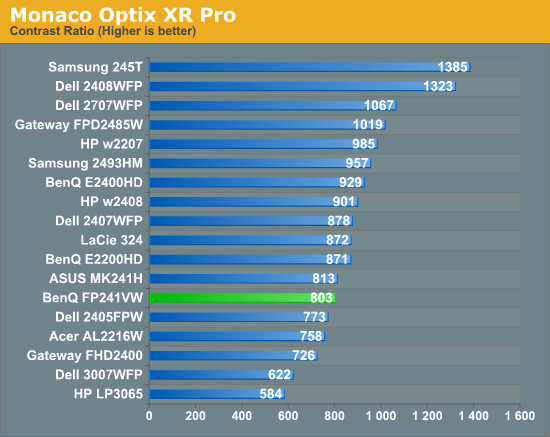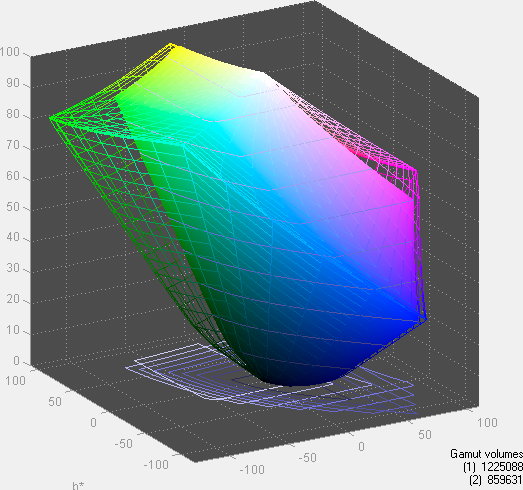Brightness and Contrast Ratio
For the brightness, contrast, and color accuracy tests, we depend on a hardware colorimeter and software to help calibrate the displays. We use a Monaco Optix XR (DTP-94) colorimeter and Monaco Optix XR Pro software, and we also test with ColorEyes Display Pro. Results in nearly every case have been better with Monaco Optix XR Pro, so for this article we're skipping the ColorEyes Display Pro results. We didn't perform a complete evaluation of the FP241VW, so we're missing maximum/minimum brightness results, but in general the display performs similarly to other LCDs.



Don't pay too much attention to the white/black graphs, as they are merely reference points for how the displays perform at certain settings. Like many other LCDs, the FP241VW has a "normal" brightness level of ~270 nits, which is more than sufficient and is actually brighter than what most users prefer to use in an office environment. You can reach the advertised 500 nits brightness if you adjust contrast and color levels as well. More important than brightness levels is the contrast ratio at the various settings. We measured a contrast ratio of 800:1 with the FP241VW, which is a decent result placing it in the lower mid section of our charts. While higher scores are better, in reality anything above 500 is sufficient for most users (i.e. the HP LP3065 that we like is at the bottom of the chart). Also, we wouldn't worry about any advertised dynamic contrast ratio numbers - at least not if you want consistent colors.
Color Gamut
Below is a comparison of color gamut for the LCDs we've tested. We use Gamutvision, a utility developed by Imatest LLC, to calculate color gamut. We compare the color profiles of the LCDs to the Adobe RGB 1998 color profile and report the results as a percentage - higher being better.


So far, color gamut has generally fallen into one of two categories: either +/-95% or +/-75%. Color gamut is determined almost exclusively by the backlighting, and the BenQ FP241VW falls short of other high-end LCDs in this area. In fact, it's at the bottom of the chart (though the difference between 70% and 75% isn't something you're likely to notice, so the bottom grouping essentially is a tie). For the original price, we would expect better, and if AU Optronics updates this particular panel we would definitely like to see a better backlight. Ideally, what we would like to see from more manufacturers is the use of LED backlighting - you can get extremely high color gamuts using RGB LEDs, and power requirements are also lower than traditional CCFL backlights. It's important to keep things in perspective, however: 70% may seem very low, but if you are using the standard sRGB profile (Windows' default) these LCDs look fine. It's only in applications like Adobe Photoshop with its expanded color space that you might notice a difference between the display color gamuts.










114 Comments
View All Comments
genegold - Saturday, August 15, 2009 - link
Jared - Take a look at HP's Business/Performance monitors for four new IPS models and two PVAs.While I've never seen a PVA monitor, one thing I've read in serious user discussions is how they are made for photo professionals and not for use with typical web/office/standard applications. For the latter, these monitors' colors are oversaturated and the text mediocre or worse. Users who have bought them for the latter frequently complain and are advised to return them for something more for the consumer market. The common theme is that these monitors are made for use with Adobe Photoshop and to some degree with other color-managed applications (of which Firefox is the only browser).
I did try a Dell 2209WA E-IPS recently, actually two samples, and found them to be very good monitors for everyday use, with the big exception for my purposes that the model's minimum brightness setting (0%) is equivalent to a bright office. That didn't work well with my moderate day lighting and evening darkness (and aging hazel eyes).
gking11 - Thursday, August 6, 2009 - link
I got my FP241VW a couple of months ago after I was lucky enough to find it for sale online, and brand new to boot!While I did get a dead pixel (fortunately it was low enough that it didn't hinder my viewing much), the display is the closest thing to perfection in terms of an all-purpose LCD, especially for gaming. With my Pantone Huey, I have it calibrated and, boy, do the colors come out!
Without further ado, here's the direct link to the site where I bought it from (it's $385 as of this post, I bought it for $400 then): http://www.entercomputers.com/benq-fp241vw-24-wide...">http://www.entercomputers.com/benq-fp24...l?SID=cf...
*Running away from stampede!*
rlx - Sunday, July 19, 2009 - link
Two points often disregarded in reviews.I bought a Samsung SM275T and although I am very happy with it, I find the readability of small anti-aliased text to be not as good as I expected. I find the reason to be that each pixel is in fact made of two pixels on that monitor. Both subpixels combine to double the number of different colors the monitor can display. I find that in some cases one subpixel is on while the one below is off.
This creates a dithering effect and somehow interacts with antia-liased text. The net effect is that I find small text to be harder to read )or I should say recognize). I compared with an analog monitor and with a 720P LCD tv and I am quite sure that using two subpixels the way Samsung does it is not the way to go for a monitor that is intended for general use.
The other point is that vertical viewing angles are very important to me on a portable computer screen. Since my vision is not that good I sometimes need to move my head closer to the screen and this movement changes the angle of view. This is why I find laptops (TN) very difficult to use. People with normal vision can do everything from a single position and the vertical angle of view might not be as important for them.
Richard
rlx - Wednesday, July 22, 2009 - link
I meant twice the number of gray levels of course (re. twice the number of colors) but why Samsung has done all that work of doubling the number of pixels just to gain one bit in the number of gray levels.If both sub-pixels have a slightly different number of levels, say sub-pixel No.1 has four levels of gray 0,1,2,3 and sub-pixel No.2 has 6 0,1,...,5 then the number of achiveable gray levels is 24 out of 31. They are 0, 3/15, 5/15, 6/15, ... up to 2.
The light coming through sub-pixel No.1 is l1/3 and the light through No.2 is l2/5. The total light through both is (l1*5 + l2*3)/15.
The 24 achivable levels out of the possible 31 are, (going from 0 to 30): 1001011011111111111111101101001.
If one scales those numbers up then one sees why Samsung can do much better than double the number of gray levels by using two sub-pixels instead of a single pixel.
Maybe I learned something from my typo.
rlx - Tuesday, July 21, 2009 - link
I just wish to clarify my statement about the readability of small size anti-aliased text on the SM275T. I double checked with my older analog SM950P that I run at 1600x1200. From a distance, the small text is definitely much easier to read on the SM275T.I am a bit annoyed by the dithering effect when I take my glasses off so I can get close to the screen. From that short range, small size text looks smooth on the analog screen while artifacts appear on the SM275T.
However even at this small range the text on the SM275T is still readable while it is not really so on the analog screen.
- Sunday, July 19, 2009 - link
Just wanted to say great review, it mirrored my sentiments exactly.P-MVAs (A-MVAs perhaps not as much) were incredible displays. Found in $300 24" soyos I was amazed how much better they were than pre-highgamut S-PVAs in every regard(color response and even slightly in gamma shift). When AUO stopped their entire MVA line it was party over for cheap high quality displays, as Samsung thinks alittle too highly of it PVA technology.
Although I still have an LG 24" with a P-MVA, my other two recent additions were H-IPS HP2475w. Great deals at $600 and worth every penny and then some, but still not bending the price curve down enough. TN has its place, but not in anything over $150 imho.
Sabresiberian - Thursday, July 9, 2009 - link
Beats the heck out of any LCD made to date. Yeah they were $2500 when they were made, but that would likely be much less now, especially if it were made for gamers not professionals and priced to sell properly to that market.Sorry, I just had to say it; maybe there's a Sony exec that reads Anandtech and will get sparked, lol!
Mr Bill - Friday, June 26, 2009 - link
I bought this monitor last fall from BenQ for $400 just before they went out of production. I wish I had bought two. Its a very nice monitor.ocyl - Thursday, June 25, 2009 - link
Thanks, Jarred, for the efforts that you've put into writing this article. Here is a bit of idea sharing :)1. You might be interested to check out NEC's MultiSync P221W (S-PVA, 1000:1 contrast, black level control, GammaComp, sRGB preset, 4-way adjustable stand, 16ms response time; $500) and the newly announced E222W (looks like a PVA given its 178º viewing angle; 1000:1 contrast, sRGB preset, 4-way adjustable stand, 5ms response time; $270). I spent two weeks of time on research when I was in the market for a new TFT-LCD monitor last November. I ended up purchasing a NEC MultiSync LCD1990SX (LTM190E4 PVA, 1500:1 contrast, ColorComp, OmniColor, black level control, sRGB preset, 4-way adjustable stand, 20ms response time; $480) and couldn't have been happier.
2. As we know, scaling is one of the main contributors to processing delay. While I don't currently own a Radeon and therefore don't know if this can be done in Catalyst, it's possible to relieve monitor from scaling tasks in ForceWare. There are four options available at nVidia Control Panel -> Display -> Change Display (Flat Panel) Scaling: Use nVidia Scaling, Use nVidia Scaling with Fixed Aspect Ratio, Use My Display's Built-in Scaling, and Do Not Scale. I don't have measuring equipment so I can't perform any meaningful investigation, but perhaps it's something that AnandTech may find worthwhile looking into.
ocyl - Friday, July 17, 2009 - link
NEC announces MultiSync EA231WMi, a 23" IPS monitorhttp://www.techpowerup.com/99491/NEC_Unveils_Multi...">http://www.techpowerup.com/99491/NEC_Un...t_23_inc...